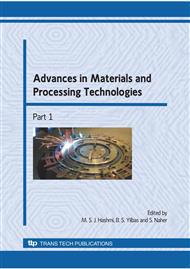p.968
p.977
p.985
p.993
p.1002
p.1009
p.1016
p.1025
p.1035
Study of Ultrasonically Assisted Internal Grinding of Small Holes: Effect of Grain Size of cBN Grinding Wheel
Abstract:
This study aims to develop an ultrasonically assisted grinding technology for precision internal grinding of a small hole measuring several millimeters in diameter, such as those formed in a fuel injector for an automotive engine. In a previous work, an experimental apparatus mainly composed of an ultrasonic vibration spindle was designed and constructed, and grinding experiments were carried out. The previous investigation found that applying ultrasonic vibration to the wheel decreased the normal and tangential grinding forces, respectively, and improved the surface roughness in surface grinding. The purpose of this paper is to examine the effect of ultrasonic vibration on grinding force and surface roughness in internal grinding when the grain sizes of small cBN grinding wheel are changed. The experimental results indicate that applying ultrasonic vibration to the wheel decreases the normal and tangential grinding forces by more than 83 % and 80 %, respectively, and improves the surface roughness by as much as 62 % while the wheel grain size is changed. In addition, over the range of grinding conditions employed in this paper, the grain size as small as 3 µm can be used in ultrasonically assisted internal grinding.
Info:
Periodical:
Pages:
1002-1008
Citation:
Online since:
December 2009
Price:
Сopyright:
© 2010 Trans Tech Publications Ltd. All Rights Reserved
Share:
Citation:


